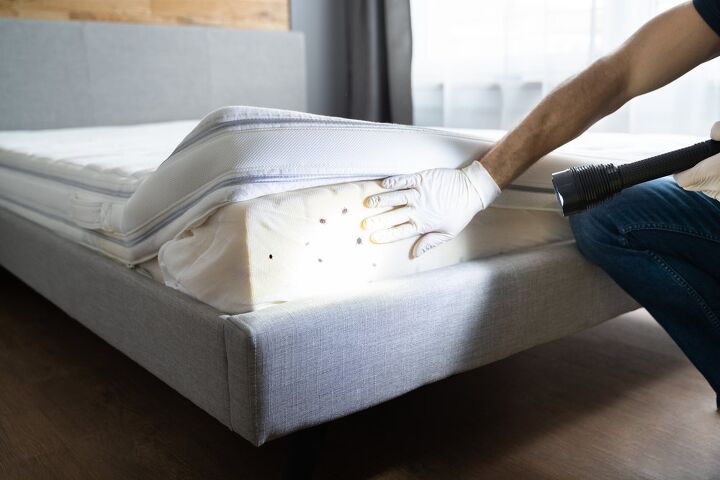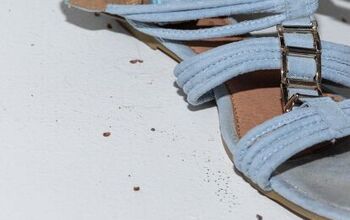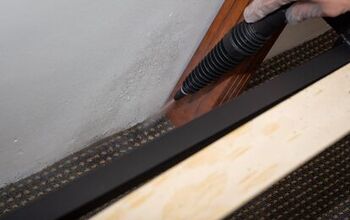Can I Sleep In My Bed After Bed Bug Treatment? (Find Out Now!)

Bed bugs can be a pain. Once you have them, it can be very hard to get rid of them. Luckily there are pest management professionals who can help you clear the bed bugs out of your home. After the exterminators have treated the affected area, is it safe to sleep in your bed?
You can sleep in your bed after most types of bed bug treatment. In fact, you won’t want to sleep in a new area in your home, because bed bugs could follow you to set up a new harborage. After treatment, wash bedding in hot water and dry on the hottest setting your material will withstand. Then, put a mattress encasing around your mattress before you go to sleep.
We’ll fill you in on what you can expect with heat treatments and chemical treatments. Also, we’ll give you tips on how to keep bed bugs away for good.
Do You Need Pest Control Services?
Get free, zero-commitment quotes from pro contractors near you.

When Can You Re-enter Your Home After Bed Bug Treatment?
How long you will need to stay away from your home after treatment will depend on what kind of treatment is used. The two main types of treatment for bed bugs are heat treatment and insecticide treatment.
Heat Treatment
A heat treatment will usually take 6 to 8 hours. In this type of treatment, the temperatures in the room or house can be raised as high as 145°F (62.7 °C). Bed bugs and their eggs will die instantly in these hot temperatures.
When the treatment is finished, you can re-enter your home as soon as the home is comfortable enough to do so. Sometimes the pest management professional (PMP) will use insecticides in combination with heat treatment. This is known as “integrated pest management.” In this case, the insecticides will need to dry before you can reenter.
Heat treatment is very effective and should kill bed bugs and their eggs on the same day. At night, you can go to sleep in your bed without worrying if more bed bugs will come to bite you during the night. However, heat treatment alone has no residual effect. You will want to take prevention steps to guard against a new infestation.
Insecticide Treatment
An insecticide treatment can take less time to carry out, but you will have to wait longer before entering your home. This treatment usually takes 30 minutes to 2 hours per room and 1 or 2 follow-up treatments will be necessary.
PMPs will typically use 3 different types of insecticides. These can include a contact insecticide for the most used areas, a residual insecticide for the nooks and crannies, and a dust insecticide to reach inside baseboards and walls.
Most recommend staying out of your home after treatment for 4-6 hours while the insecticides dry. However, pregnant women, babies under 18 months, people with breathing problems, and any pets should stay out of the home for at least 12 hours before reentering.
In an insecticide treatment, it may take a few weeks before all the bed bugs die off. You should sleep in your bed because if you sleep in a new area, the bed bugs will follow you there and a new infestation can begin. You can use a mattress encasement that entirely encases your mattress that will keep the bugs from being able to get to you at night. The encasement itself will not kill off bed bugs, but if the mattress has been treated, the bugs will die off inside as they will eventually be forced to come in contact with the insecticide.
How to Prepare for Bed Bug Treatment
Before the professionals get to work, you will need to prepare the home for treatment. Generally, you don’t want to remove any items from the home. Small bed bugs or eggs could be hidden in these items and you can run the risk of reintroducing bed bugs into your home. Also, you could potentially spread bed bugs to a new area. However, if you are heat treating your home, you will need to remove anything that could melt at 150 degrees. Ask the PMP how you can treat these items separately.
Here are some steps to follow before the professional exterminators come in to make the treatment the most effective:
Step 1: Remove your bedding from the bed
Before exterminating bed bugs, you will want to take off all bedding so the treatment can get to the bed bugs’ harborage in your mattress. Make sure you keep contaminated bedding separate from unaffected bedding or clothes.
Step 2: Do not set small items on a couch or bed
If you set small items on top of your bed or sofa, this could block the treatment from being able to get to the nooks and crannies of your bed.
Step 3: Move furniture at least 2 feet away from walls
Bed bugs hide away from the light and can hide in baseboards or in walls. You will want to move the furniture and any small items away from the walls so the treatment can effectively reach the bed bugs’ harborage. If bugs are living in the crevices in your baseboards or walls, they will be forced to come in contact with the insecticide when they come out at night.
Step 4: Put food away in a pantry, cupboard, or storage containers
Make sure no food is left exposed, especially if you are treating the home with insecticide.
Step 5: Label bags and containers clearly
Label carefully any bedding that has been on your bed when the bed bugs were present. Bed bugs will die immediately at 122 degrees Fahrenheit, so you will want to wash and dry this contaminated bedding at high temperatures to kill any bugs. Many also recommend that you wash even unused bedding and clothes for at least 30 minutes and dry them for 30 minutes. This is a preventative measure in case any bed bugs took up residence in your clean laundry.
Step 6: Take pets with you
You will want to take all pets out of the home when the exterminator comes. This goes for cats and dogs as well as gerbils and fish.
Step 7: Follow the PMPs prevention directions
When your Pest Management Professional has finished treatment, they may give you specific directions for follow-up. You will want to follow their advice, and keep any follow-up appointments to prevent a subsequent infestation of bed bugs. The Environmental Protection Agency also has online guidelines to prevent bed bugs from re-entering your home.
If you are not sure if enough time has elapsed after treatment to safely sleep in your bed, ask your PMP for advice.
Do You Need Pest Control Services?
Get free, zero-commitment quotes from pro contractors near you.

Related Questions
How fast can bed bugs move?
Bed bugs can get around quickly and hide out well. They are capable of traveling 3-4 feet per minute. They usually feed when people have reached their deep sleep cycle. This means you may not feel the bite until much later. These 2 factors combined are reasons why you may not have noticed you have a bed bug problem until they have multiplied.
Do you treat just the affected room or the whole house for bed bugs?
Just because one room has bed bugs luckily does not mean that all your rooms do. Still, bed bugs move quickly so you will want to set traps to see if bedbugs have infested other areas. Use preventative measures to keep the bugs from moving from room to room.
How much does bed bug treatment cost?
According to homeadvisor.com bed bug treatment on average will cost $200-$400 per room. A homeowner could end up paying anywhere from $300 to $5,000 for treatment depending on the size of the infestation.

Alex Praytor is a native Texan who got her degree in English Literature and decided to travel the globe. She finds the architecture and design of homes across cultures fascinating. In her spare time, she visits coffee shops with her family and creates projects for their own home. Alex enjoys sharing tips on how to keep repairs up to date while turning a house into a home.
More by Alex Praytor



























